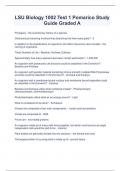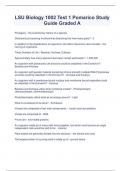Plant systematics - Study guides, Class notes & Summaries
Looking for the best study guides, study notes and summaries about Plant systematics? On this page you'll find 130 study documents about Plant systematics.
Page 4 out of 130 results
Sort by

-
Test Bank For Biology, 6th Edition Brooker (All Chapters included)
- Exam (elaborations) • 921 pages • 2024
-
- $19.99
- + learn more
Complete Test Bank for Biology, 6th Edition by Robert Brooker, Eric P. Widmaier, Linda E. Graham, Peter D. Stiling ; ISBN13: 9781264039715. Full Chapters included Chapter 1 to 60. 1. An Introduction to Biology. 2. The Chemical Basis of Life I: Atoms, Molecules, and Water. 3. The Chemical Basis of Life II: Organic Molecules. 4. Evolutionary Origin of Cells and Their General Features. 5. Membrane Structure, Synthesis and Transport. 6. An Introduction to Energy, Enzymes, and Metabolism. 7. Cellular...

-
LSU Biology 1002 Test 1 Pomarico Study Guide Graded A
- Exam (elaborations) • 8 pages • 2023
-
- $10.99
- + learn more
Phylogeny - the evolutionary history of a species Dichotomous branching involves lines branching into how many parts? - 2 In addition to the classification of organisms, the field of taxonomy also includes - the naming of organisms Three Domains of Life - Bacteria, Archaea, Eukarya Approximately how many species have been named world-wide? - 1,500,000 An organism with prokaryotic cell structure could be classified in the Domain/s? - Bacteria and Archaea An organism with genetic...

-
OSMT Exam Questions with verified Solutions 100% Solved 2024
- Exam (elaborations) • 10 pages • 2024
- Available in package deal
-
- $12.49
- + learn more
OSMT Exam Questions with verified Solutions 100% Solved 2024 Why doesn't phylogenetic systematics have a fixed number of hierarchical categories like Linnaean systematics? - answerEach branching point is a hierarchical level in the nested structure of phylogenetic systematics. The number of branching points—and therefore the number of possible hierarchical levels—varies substantially from one lineage to another. What aspect of evolution does phylogenetic systematics represent more cle...

-
TAMU Biology 113 Final Exam Questions and Answers 100% Pass
- Exam (elaborations) • 12 pages • 2024
- Available in package deal
-
- $13.49
- + learn more
TAMU Biology 113 Final Exam Questions and Answers 100% Pass Taxonomy - Answer- naming and classifying organisms systematics - Answer- study of biological diversity on earth Taxonomy is part of this. most general to most specific domain, kingdom, phylum, class, order, family, genus, species - Answer- Taxonomic hierchy of classification Genus + species - Answer- scientific name (scientific nomenclature) Ex. Lupinus texensis upper case (scientific name) - Answer- Genus lower case (sci...

-
EXAM #1 General Biology 1 Questions and Answers with complete solution
- Exam (elaborations) • 22 pages • 2024
- Available in package deal
-
- $7.19
- + learn more
Multicellular - Answer-If an organism consists of more than one cell it is said to be a(n) _____________ organism. 1. Homeostasis 2. Responsiveness 3. Organization - Answer-Which of the following are characteristics shared by ALL living organisms? Atom - Answer-Which of the following is the smallest unit of matter? Cell - Answer-Life is based on a(n) _______________, the structural and functional unit of all living organisms. Cells - Answer-A tissue consists of a group of similar _______...

-
TAMU Biology 113 Final Exam Questions and Answers 100% Pass
- Exam (elaborations) • 12 pages • 2024
-
- $12.49
- + learn more
TAMU Biology 113 Final Exam Questions and Answers 100% Pass Taxonomy - Answer- naming and classifying organisms systematics - Answer- study of biological diversity on earth Taxonomy is part of this. most general to most specific domain, kingdom, phylum, class, order, family, genus, species - Answer- Taxonomic hierchy of classification Genus + species - Answer- scientific name (scientific nomenclature) Ex. Lupinus texensis upper case (scientific name) - Answer- Genus lower case (sci...

-
BSC1005 EXAM 4
- Exam (elaborations) • 8 pages • 2024
-
Available in package deal
-
- $9.79
- + learn more
BSC1005 EXAM 4 The field of science that involves assigning names to organisms is known as taxonomy. Organisms are classified in a hierarchy that includes domains, kingdoms, phyla, classes, orders, families, genera, and species. The Linnaean system consists of a structured hierarchy in which taxonomic groups are organized systematically, and it is incorrect to say that scientists categorize organisms into three domains of plants, animals, and protists; instead, there are three domains...

-
LSU Biology 1002 Test 1 Pomarico Study Guide Graded A
- Exam (elaborations) • 8 pages • 2023
-
- $10.99
- + learn more
Phylogeny - the evolutionary history of a species Dichotomous branching involves lines branching into how many parts? - 2 In addition to the classification of organisms, the field of taxonomy also includes - the naming of organisms Three Domains of Life - Bacteria, Archaea, Eukarya Approximately how many species have been named world-wide? - 1,500,000 An organism with prokaryotic cell structure could be classified in the Domain/s? - Bacteria and Archaea An organism with genetic...

-
WKU Bio 316 Exam 1 Questions And Answers With 100% Correct Answers
- Exam (elaborations) • 5 pages • 2024
- Available in package deal
-
- $7.99
- + learn more
Gene - Linear sequence of nucleotides, coding instruction for transcription of RNA, and translation to a protein Anaximander (610-546 BC) - Speculated: Early animals rose from the ocean, humans came from the mouths of giant fish, and complexity rose from simple life. Aristotle (384-322 BC) - Advocated the importance of observation, wrote "History of Animals", also wrote "Scala Natural" Biological Evolution - Change in populations over time Biology - Study of Life Carolus Linnaeus () ...

-
Botany Exam 1 Questions And Complete Solutions
- Exam (elaborations) • 10 pages • 2023
- Available in package deal
-
- $13.49
- + learn more
Botany Exam 1 Questions And Complete Solutions

Do you wonder why so many students wear nice clothes, have money to spare and enjoy tons of free time? Well, they sell on Stuvia! Imagine your study notes being downloaded a dozen times for $15 each. Every. Single. Day. Discover all about earning on Stuvia


